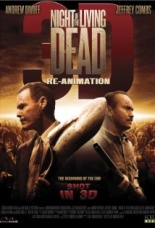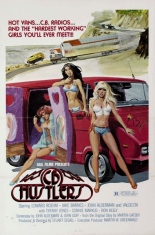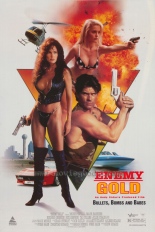
 Which is the worst part of the complicated rights issue with the original 1968 Night of the Living Dead? Is it:
Which is the worst part of the complicated rights issue with the original 1968 Night of the Living Dead? Is it:
A. that director George A. Romero and company were screwed out of millions, or
B. that it allowed Jeff Broadstreet to make Night of the Living Dead 3D: Re-Animation?
With apologies to those good people’s bank accounts, the answer is B. Trust me on this one. You’d agree if you saw this abomination, but I encourage you to run in the other direction. The answer is totally B.
Even if writer/director/producer Broadstreet — who also helmed the 2006 Night of the Living Dead 3D “remake” — had left the classic film’s title off his own, the results still would remain abortive. Ladies and gentlemen, we have the 21st-century Ed Wood. The difference is that nobody will be watching Broadstreet’s work after he passes. Hell, they shouldn’t be watching it while he’s alive, either.
 It took me four tries to start NOTLD3D:R-A before I could muster the strength to watch it all the way through. Andrew Divoff (Wishmaster) fronts the film as Gerald Tovar Jr., a second-generation mortician who doesn’t cremate the corpses he’s paid to; instead, he piles them into one dank dungeon of a room, which characters can enter and somehow not vomit from the stench. Guess what happens to the bodies. (Did you say “zombies”?)
It took me four tries to start NOTLD3D:R-A before I could muster the strength to watch it all the way through. Andrew Divoff (Wishmaster) fronts the film as Gerald Tovar Jr., a second-generation mortician who doesn’t cremate the corpses he’s paid to; instead, he piles them into one dank dungeon of a room, which characters can enter and somehow not vomit from the stench. Guess what happens to the bodies. (Did you say “zombies”?)
I suppose NOTLD3D:R-A holds a curiosity factor among those wishing to see Divoff act alongside Re-Animator‘s Jeffrey Combs, who plays Gerald’s no-good, conspiracy-prone teabagger brother. To horror-con geeks, this sounds akin to Pacino and De Niro’s diner scene in Heat. It’s not; it’s the gum under the table at that diner. And I like both actors.
This chore of a watch is all about CGI blood and green-screen antics and, because of shooting in three dimensions, intrusive angles. The 3-D doesn’t even work, so why bother? On the disc’s production featurette, Broadstreet tells you why: Because he thinks he’s making a sociopolitical statement. He’s delusional; he’s made the A/V equivalent of a bowel movement. I hate to be so harsh, but this time, it’s merited. —Rod Lott


 Odds are, the amateurish, plotless sex comedy known as
Odds are, the amateurish, plotless sex comedy known as  There’s not a laugh to be had in this mix of Hal Needham and
There’s not a laugh to be had in this mix of Hal Needham and 
 With
With  Flowing readily from co-writer Christian’s pen are exchanges such as one in which male lead Chris Cannon (Bruce Penhall) discusses the agents’ newest weapon of defense: crossbow arrows with tips that “explode three seconds following penetration.” Becky replies, “Like old boyfriends.” Rimshot! The best line, however, comes after a naked lady in a shower asks Santiago, “What’s up?” and he says, “I am.” (Get it? He means he totally has a boner.)
Flowing readily from co-writer Christian’s pen are exchanges such as one in which male lead Chris Cannon (Bruce Penhall) discusses the agents’ newest weapon of defense: crossbow arrows with tips that “explode three seconds following penetration.” Becky replies, “Like old boyfriends.” Rimshot! The best line, however, comes after a naked lady in a shower asks Santiago, “What’s up?” and he says, “I am.” (Get it? He means he totally has a boner.)
 Part kick-’em-up revenge tale and part sappy love story (guess which part I didn’t care for?),
Part kick-’em-up revenge tale and part sappy love story (guess which part I didn’t care for?),  Prior to the attack, Cao Lei feigns disinterest in his pregnant girlfriend so she’ll skip town and, thus, be safe. But she runs into the arms of a not-so-nice guy who, it is revealed with no surprise, is a rival clan leader. So Cao Lei must save her, but first he is nearly killed (with intrigue) and then brought back to his vital self by his enemy, a scar-faced woman who then scars him, making his face look like he has an expired Steak-umm glued to one side.
Prior to the attack, Cao Lei feigns disinterest in his pregnant girlfriend so she’ll skip town and, thus, be safe. But she runs into the arms of a not-so-nice guy who, it is revealed with no surprise, is a rival clan leader. So Cao Lei must save her, but first he is nearly killed (with intrigue) and then brought back to his vital self by his enemy, a scar-faced woman who then scars him, making his face look like he has an expired Steak-umm glued to one side.
 Lola doesn’t accept rejection well — like, at all. With the help of her father (John Brumpton,
Lola doesn’t accept rejection well — like, at all. With the help of her father (John Brumpton,